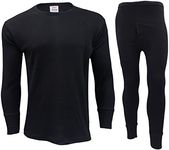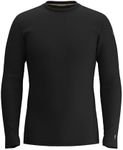Buying Guide for the Best Mens Thermals
When it comes to picking the right men's thermals, it's important to consider a few key factors to ensure you stay warm and comfortable in cold weather. Thermals are designed to provide insulation and wick away moisture, making them essential for layering during winter activities or simply staying cozy indoors. Understanding the different specifications and how they relate to your needs will help you make an informed decision.MaterialThe material of thermals is crucial because it determines the warmth, comfort, and moisture-wicking properties. Common materials include cotton, wool, and synthetic blends. Cotton is soft and breathable but not the best at moisture-wicking. Wool, especially merino wool, is excellent for warmth and moisture management but can be more expensive. Synthetic blends, like polyester or spandex, offer good moisture-wicking and durability. Choose cotton for light activities or indoor use, wool for maximum warmth and outdoor activities, and synthetics for high-intensity activities where moisture-wicking is essential.
WeightThermal weight refers to the thickness and warmth of the fabric. Lightweight thermals are thin and suitable for mild cold or as a base layer under other clothing. Midweight thermals offer more warmth and are versatile for various cold weather conditions. Heavyweight thermals provide maximum insulation and are ideal for extremely cold temperatures or low-activity situations. Consider the climate and your activity level when choosing the weight; lightweight for mild conditions, midweight for moderate cold, and heavyweight for extreme cold.
FitThe fit of thermals affects both comfort and performance. A snug fit ensures better insulation and moisture-wicking, as it traps body heat and moves sweat away from the skin. However, it should not be too tight to restrict movement or cause discomfort. A looser fit may be more comfortable for lounging but less effective in retaining heat. For active use, opt for a snug fit that allows for a full range of motion. For casual wear, a slightly looser fit may be more comfortable.
SeamsSeams in thermals can impact comfort, especially during prolonged wear or high activity levels. Flatlock seams are designed to lie flat against the skin, reducing chafing and irritation. Regular seams may be more noticeable and can cause discomfort under layers or during movement. If you plan to wear thermals for extended periods or during physical activities, look for flatlock seams to enhance comfort.
Moisture-WickingMoisture-wicking is the ability of the fabric to draw sweat away from your skin and allow it to evaporate. This is important to keep you dry and prevent chills in cold weather. Materials like wool and synthetic blends are excellent at moisture-wicking, while cotton is less effective. If you expect to sweat or engage in physical activities, prioritize thermals with good moisture-wicking properties to stay dry and comfortable.
Odor ResistanceOdor resistance is a feature that helps prevent the buildup of unpleasant smells caused by sweat and bacteria. Wool, particularly merino wool, naturally resists odors, while some synthetic fabrics are treated with antimicrobial agents to achieve the same effect. If you plan to wear your thermals for extended periods or during intense activities, consider those with odor-resistant properties to stay fresh.

















